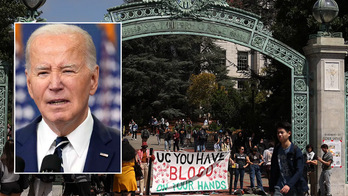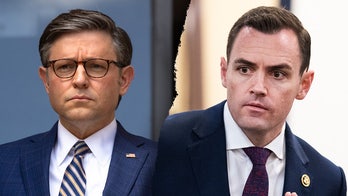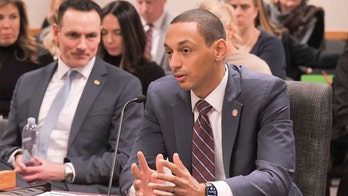The head of the Bureau of Alcohol, Tobacco, Firearms and Explosives' office in Phoenix during the failed “Operation Fast and Furious” acknowledged Wednesday his earlier testimony to a House panel “lacked clarity” and completeness, and he offered new insight into his own mistakes in the investigation and allegations that officials ignored agents’ concerns.
“After taking time to reflect and review my testimony from the hearing on July 26, 2011, I realize I could have given clearer, more complete and more direct responses to some questions,” former Special Agent in Charge William Newell said in a 12-page document submitted to the House Government Reform and Oversight Committee and obtained by Fox News.
In a “supplemental statement,” Newell insisted agents did not knowingly allow thousands of weapons to reach criminal hands. Any concerns raised over the program were never voiced to appropriate authorities, he said, and only once did higher-ups tell agents not to arrest a suspect -- when the safety of the agents was in jeopardy.
He tried to emphasize his points during the July hearing, but even Democrats then described his testimony, under oath, as “quite frustrating.”
Of nearly 2,000 weapons sold to suspected “straw” purchasers over several months, the ATF was notified in time and able to monitor the purchase of only about 300 firearms, Newell said. In fact, of the 2,000 weapons sold to suspects, as many as 400 of them were sold before “Fast and Furious” ever launched. Still, Newell acknowledged ATF “was able to proactively and lawfully” seize only a fifth of the nearly 300 weapons under ATF surveillance.
“With 20/20 hindsight, I now see that I should have conducted more frequent assessments,” Newell said in his filing. “With more regular assessments I could have articulated to my staff the need to be proactive in ascertaining the quantity of guns being purchased that we were not able to intercept.”
In his filing Wednesday, Newell said agents could only track guns when dealers notified them of an upcoming purchase. This was highlighted by the murder of Border Patrol agent Brian Terry in December 2010 along the Southwest Border. Weapons tied to “Fast and Furious” were found at the scene, and others have surfaced at other crime scenes in the United States. Meanwhile, many of the high-powered rifles lost under “Fast and Furious” ended up in Mexico.
In the case of Border Patrol agent Terry's murder, ATF was notified of the weapons' purchase three days after the sale.
“As such, ATF agents could not have surveilled the purchase, storage and/or transportation of those firearms,” Newell said in his filing.
That is not likely to curb some of the investigation’s most outspoken critics. Rep. Darrell Issa, R-Calif., who as chairman of the House Oversight Committee has launched an investigation into the controversial program, has repeatedly called it “reckless.”
In the filing Wednesday, Newell said any mistakes were “unintentional errors of omission” rooted in, among other things, “the laws we have at our disposal.”
“Fast and Furious” was launched in late 2009 by ATF, in conjunction with Justice Department officials in Arizona. Investigators planned to follow gun purchasers in hopes that suspects would lead them to the heads of Mexican cartels. In his filing Wednesday, Newell said ATF had identified an “expansive and expanding firearms trafficking network,” and it was “important” to “terminate” it. But lower-level suspects “generally refuse to cooperate” and offer law enforcement only limited information on such organizations "due to [their] insular design.” Thus, “Fast and Furious” was born.
Even when ATF agents were able to track a suspect, though, seizure of any weapons purchased was not guaranteed. In one instance, a suspected gun-runner bought 20 AK-47 type rifles, but he “maintained” to law enforcement the weapons “belonged to him,” Newell said. He “was not prohibited by law from purchasing or possessing the firearms,” and ATF agents felt they did not have “lawful authority to seize the weapons,” according to Newell.
A report issued in June by Issa and Sen. Charles Grassley, R-Iowa, said the “volume, frequency, and circumstances of these transactions clearly established reasonable suspicion to stop and question the buyers.”
Nevertheless, of the nearly 2,000 weapons sold to suspects, the vast majority of guns have yet to be recovered.
“The deadly consequences of this irresponsible program could last for years to come,” Issa said during the July hearing. “[Weapons] are still out there waiting to kill.”
In his new filing, Newell also tried to push back on suggestions from whistleblowers and others that ATF agents had repeatedly raised concerns about “Fast and Furious,” insisting he was “unaware” of any such concerns until they were voiced publicly on TV.
“To me, the stark absence of contemporaneous documents voicing concerns to supervisors over 'guns walking,' establishes quite convincingly that concerns over alleged 'gun walking' were not raised with the appropriate supervisors in the Phoenix Field Division during the operational phase of this investigation,” Newell said in his filing.
In addition, he said there is a “well-established process” for voicing concerns to ATF's Internal Affairs Division or Office of the Ombudsman, and, “To the best of my knowledge, at no time during the operational phase of the ‘Fast and Furious’ investigation did any of the whistleblowers contact [them] with concerns regarding the investigation.”
In an interview with House Oversight Committee investigators in April, one of the chief whistleblowers, ATF agent John Dodson, told investigators he shared his concerns with several fellow agents and with supervisor David Voth. In addition, he said he remembers a meeting as early as February 2010 in which an unidentified Assistant Special Agent in Charge told agents to, in Dodson’s words, “stand down with our complaints” over “gun walking.”
Meanwhile, questions continued to mount Wednesday over whether a third gun -- not part of the “Fast and Furious” investigation -- may have been found at the murder scene. Some critics have used word of a third weapon to accuse the federal government of covering up evidence in the case.
An FBI spokesman insists reports of a third weapon are “false,” stating emphatically, “There is no third gun.” And Newell's attorney, Paul Pelletier, who recently left the Justice Department for private practice, said he has access to case materials, and there were only two guns found at the murder scene.
The report released in June by Issa and Grassley stated a third weapon was recovered at the scene. In emails Tuesday and Wednesday, a Grassley spokeswoman said her office obtained information of a third weapon from Terry's family, who was told of it by a Border Patrol agent at Terry's funeral. They also learned of a third weapon from newly disclosed recordings of conversations between an ATF agent and an Arizona gun dealer referencing an SKS rifle, and “other documentation.”
In those newly disclosed recordings, the ATF noted that “all [she] can go by is what” the FBI told her. Pelletier, now with Mintz Levin in Washington, said he believes he knows the origin of the three-gun “misperception.” He said the FBI originally identified one of the two guns recovered as an SKS, made in China.
After ATF agents traced the guns' serial numbers back to “Fast and Furious,” they knew that both guns were in fact AK-47s from Romania. Some FBI officials, though, kept referring to an SKS, causing “initial confusion” and leading others to believe there was an SKS in addition to the two AK-47s, according to Pelletier.
Grassley's spokeswoman was skeptical of such an explanation, noting that it would seem “difficult to misidentify one of the AK guns, since they would be identical.” And, she said, the ATF agent in the recordings said the third weapon had been traced to Texas, not Arizona.
In a separate case not tied to “Fast and Furious” -- the murder of Immigration and Customs Enforcement agent Jaime Zapata in Mexico -- weapons involved were traced to Texas.
Overall, Grassley's spokeswoman said of the Terry murder and weapons recovered at the scene, “Anything is possible with this case.”
Repeated emails to Issa’s office seeking comment were not returned. Asked about Newell’s filing Wednesday afternoon, Grassley’s spokeswoman suggested her office had only just received it, saying his office was “looking over [it] now.”
At least three men have been charged in connection with the murder of Terry, though only one is in U.S. custody. In addition, the Justice Department's inspector general has launched its own investigation in “Fast and Furious,” at the direction of Attorney General Eric Holder.




